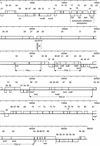R391: a conjugative integrating mosaic comprised of phage, plasmid, and transposon elements
- PMID: 12193633
- PMCID: PMC135318
- DOI: 10.1128/JB.184.18.5158-5169.2002
R391: a conjugative integrating mosaic comprised of phage, plasmid, and transposon elements
Abstract
The conjugative, chromosomally integrating element R391 is the archetype of the IncJ class of mobile genetic elements. Originally found in a South African Providencia rettgeri strain, R391 carries antibiotic and mercury resistance traits, as well as genes involved in mutagenic DNA repair. While initially described as a plasmid, R391 has subsequently been shown to be integrated into the bacterial chromosome, employing a phage-like integration mechanism closely related to that of the SXT element from Vibrio cholerae O139. Analysis of the complete 89-kb nucleotide sequence of R391 has revealed a mosaic structure consisting of elements originating in bacteriophages and plasmids and of transposable elements. A total of 96 open reading frames were identified; of these, 30 could not be assigned a function. Sequence similarity suggests a relationship of large sections of R391 to sequences from Salmonella, in particular those corresponding to the putative conjugative transfer proteins, which are related to the IncHI1 plasmid R27. A composite transposon carrying the kanamycin resistance gene and a novel insertion element were identified. Challenging the previous assumption that IncJ elements are plasmids, no plasmid replicon was identified on R391, suggesting that they cannot replicate autonomously.
Figures




References
Publication types
MeSH terms
Substances
Associated data
- Actions
LinkOut - more resources
Full Text Sources
Other Literature Sources
Molecular Biology Databases

